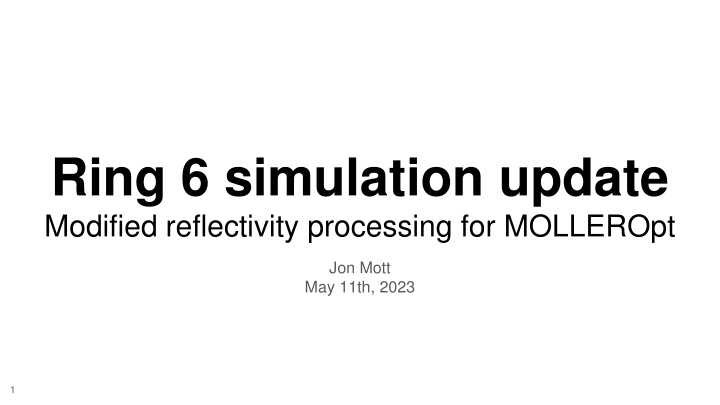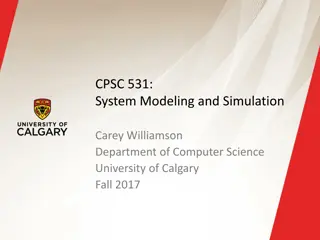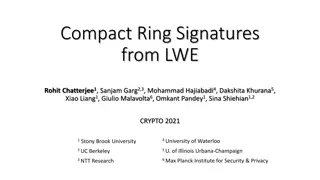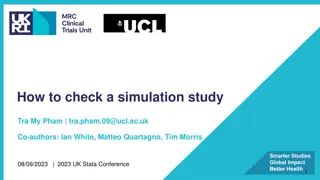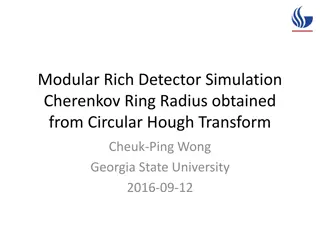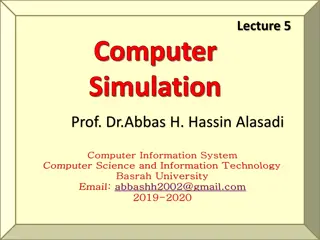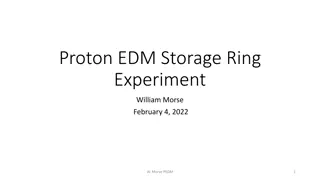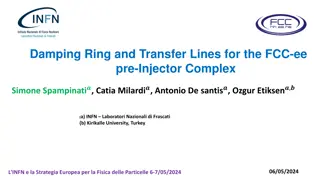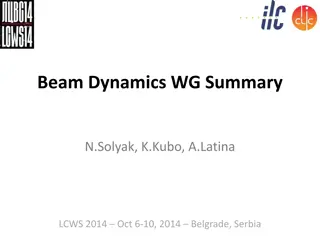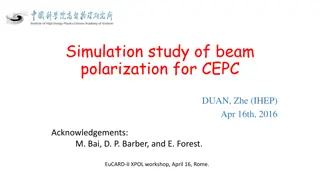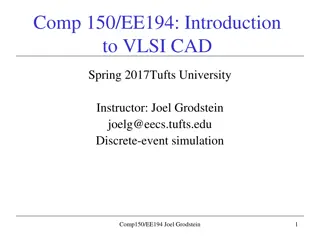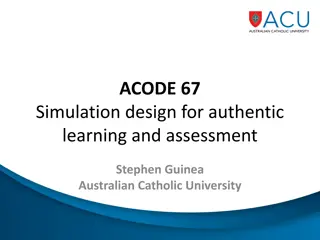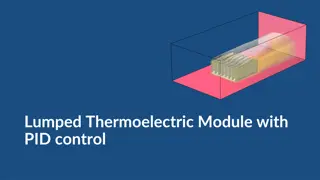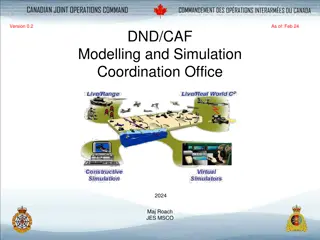Ring 6 simulation update
This update showcases modifications made to the reflectivity processing for Ring 6 simulation in MOLLEROpt, addressing discrepancies with beam and cosmic data. Changes include sorting reflectivity into angular bins, aligning angles with measurements, and adjusting reflection handling for improved accuracy.
Uploaded on Feb 16, 2025 | 2 Views
Download Presentation

Please find below an Image/Link to download the presentation.
The content on the website is provided AS IS for your information and personal use only. It may not be sold, licensed, or shared on other websites without obtaining consent from the author.If you encounter any issues during the download, it is possible that the publisher has removed the file from their server.
You are allowed to download the files provided on this website for personal or commercial use, subject to the condition that they are used lawfully. All files are the property of their respective owners.
The content on the website is provided AS IS for your information and personal use only. It may not be sold, licensed, or shared on other websites without obtaining consent from the author.
E N D
Presentation Transcript
Ring 6 simulation update Modified reflectivity processing for MOLLEROpt Jon Mott May 11th, 2023 1
Outline: Comparison of old simulations to beam and cosmic data Discrepancy between simulations and beam/cosmic data for Ring 6 10mm R6 w/ Heraeus 20mm R6 w/ Tosoh Possible solutions to this problem Made changes to how MOLLEROpt simulations process reflectivity of the light guide Changed how the angle dependent reflectivity is sorted into angular bins Redefined the simulation s reflectivity angles to be consistent with measurements Comparison of new simulations to beam and cosmics 10mm R6 w/ Heraeus 20mm R6 w/ Tosoh 20mm R6 w/ Heraeus 2
Comparison of old simulation with cosmic and beam data PE yield (Miro-silver) PE yield (Mylar) Sigma (PE) (Miro-silver) Sigma (PE) (Mylar) Module Quartz tile Data type 3.78 (Langau) 11.58 (Langau) 2.52 (Langau) 3.56 (Langau) 10 mm Heraeus cosmic 4.68 (Langau) 2.13 (Langau) 10 mm Heraeus beam - - 3.66 (Langau) 8.83 1.71 (Langau) 2.47 10 mm Heraeus simulation (Langau) (Langau) PE yield (Miro-silver) PE yield (Mylar) Sigma (PE) (Miro-silver) Sigma (PE) (Mylar) Module Quartz tile Data type 7.96 (Langau) 15.96 (Langau) 3.28 (Langau) 3.56 (Langau) 20 mm Tosoh cosmic 9.16 (Langau) 3.02 (Langau) 20 mm Tosoh beam - - 5.72 (Langau) 11.92 (Langau) 2.30 (Langau) 3.29 (Langau) 20 mm Tosoh simulation Simulated PE yield is significantly lower than beam and cosmic results To determine the cause, changes were made to how the simulations handle the reflectivity of the light guide 3
Old setup for handling light guide reflections Data angle [ ] Simulation angle [ ] Simulation bin Is it selected 30 60 > 45 yes 45 45 45 >= > 30 yes 60 30 30 >= > 0 yes 90 0 = 0 no MOLLEROpt assumes that the reflectivity of the light guide can be sorted into angular bins, where each bin has an associated energy dep. reflectivity Data angles were measured relative to the material plane (90 = normal) The angle values in the simulation were flipped relative to the data This setup was leading to PE values that disagreed with cosmic and beam test data 4
Adjusting the binning Simulation angle [ ] Data angle [ ] Simulation bin Is it selected 30 60 90 >= > 52.5 yes 45 45 52.5 >= > 37.5 yes 60 30 37.5 >= > 15 yes 90 0 <= 15 yes The binning was updated so that the sim would choose the reflectivity file with an angle closest to the actual reflection angle This led to a slight increase in the PE yield, but not enough to explain the discrepancy with actual data, so further changes were made 5
Changing the definition of the reflection angles Simulation angle [ ] Data angle [ ] Simulation bin Is it selected 30 30 37.5 > = >= 0 yes 45 45 52.5 >= > 37.5 yes 60 60 75 >= > 52.5 yes 90 90 > 75 yes Changed how the simulation chooses which reflectivity file to load. A 30 reflection on the LG will now load the 30 data file rather than the 60 file Kept the new binning structure from the previous change This configuration led to results that agree well with our cosmics 6
Comparison of new simulation with cosmic and beam data PE yield (Miro-silver) PE yield (Mylar) Sigma (PE) (Miro-silver) Sigma (PE) (Mylar) Module Quartz tile Data type 3.78 (Langau) 11.58 (Langau) 2.52 (Langau) 3.56 (Langau) 10 mm Heraeus cosmic 4.68 (Langau) 2.13 (Langau) 10 mm Heraeus beam - - 3.66 -> 4.03 (Langau) 8.83 -> 11.4 (Langau) 1.71 -> 1.76 (Langau) 2.47 -> 3.17 (Langau) 10 mm Heraeus simulation PE yield (Miro-silver) PE yield (Mylar) Sigma (PE) (Miro-silver) Sigma (PE) (Mylar) Module Quartz tile Data type 7.96 (Langau) 15.96 (Langau) 3.28 (Langau) 3.56 (Langau) 20 mm Tosoh cosmic 9.16 (Langau) 3.02 (Langau) 20 mm Tosoh beam - - 5.72 -> 6.24 (Langau) 11.92 -> 15.1 (Langau) 2.30 -> 2.37 (Langau) 3.29 -> 3.74 (Langau) 20 mm Tosoh simulation Simulations are in much better agreement than before, especially for the mylar For the Tosoh quartz, we are currently investigating whether the remaining discrepancy is due to how Tosoh is implemented in the sims 7
Simulations with Heraeus spectrosil 2000 Hits on center of quartz vs. evenly distributed PE yield (Langau) Sigma (PE) (Langau) Resolution (Langau) Module LG material 10 mm Miro-silver 4.03 1.76 43.7% 10 mm UVS 7.71 2.62 34.0% MP: 20.2 pes Sigma: 4.23 Res: 20.9% 10 mm Mylar 11.4 3.17 27.8% PE yield (Langau) Sigma (PE) (Langau) Resolution (Langau) Module LG material - 20 mm Miro-silver - - 20 mm UVS 13.7 3.50 25.5% 20 mm Mylar 20.2 4.23 20.9% MP: 21.7 pes Sigma: 4.38 Res: 20.2% Data above is for a beam striking the center of the quartz. Simulations for an even distribution give similar to slightly higher results 8
